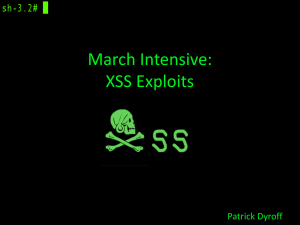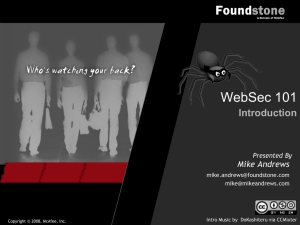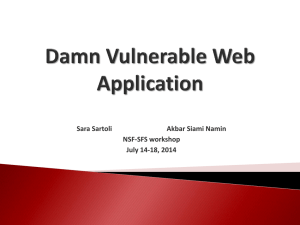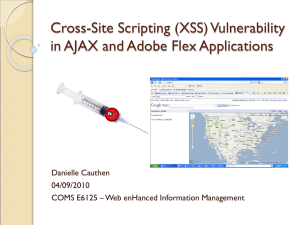Cross Site Scripting (XSS)
advertisement
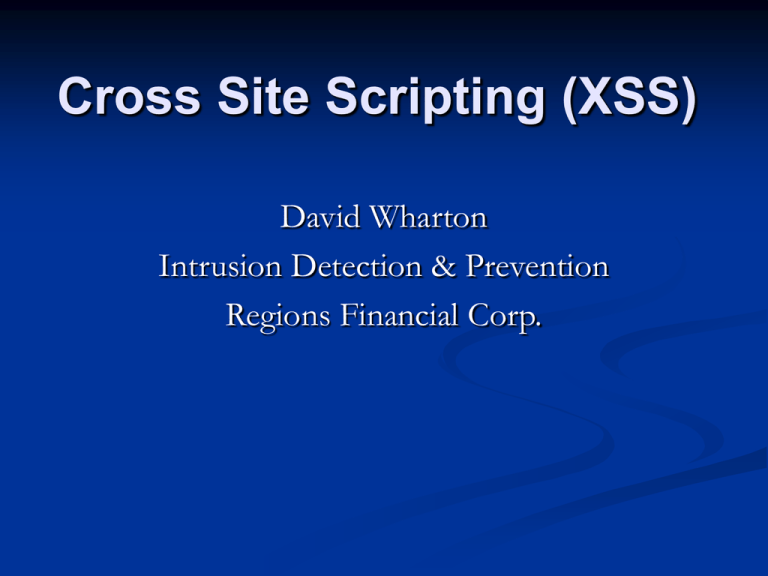
Cross Site Scripting (XSS)
David Wharton
Intrusion Detection & Prevention
Regions Financial Corp.
Overview
Introduction
What is XSS?
Is XSS Important?
Exploiting XSS
Preventing XSS
BeEF Demo
Conclusion
Questions
Introduction
What is XSS?
XSS is a vulnerability that allows an attacker to run
arbitrary JavaScript in the context of the vulnerable
website.
XSS bypasses same-origin policy protection
“The policy permits scripts running on pages
originating from the same site to access each other's
methods and properties with no specific restrictions,
but prevents access to most methods and properties
across pages on different sites.“
“The term ‘origin’ is defined using the domain name,
application layer protocol, and (in most browsers)
Types of XSS
Reflected XSS
Stored XSS (a.k.a. “Persistent XSS”)
DOM Based XSS
Reflected XSS
Reflected XSS Example
Exploit URL:
http://www.nikebiz.com/search/?q=<script>alert('
XSS')</script>&x=0&y=0
HTML returned to victim:
<div id="pageTitleTxt"> <h2><span
class="highlight">Search Results</span><br />
Search: "<script>alert('XSS')</script>"</h2>
Reflected XSS Example
Stored XSS
JavaScript supplied by the attacker is stored by
the website (e.g. in a database)
Doesn’t require the victim to supply the
JavaScript somehow, just visit the exploited web
page
More dangerous than Reflected XSS
Has resulted in many XSS worms on high profile
sites like MySpace and Twitter (discussed later)
DOM Based XSS
Occur in the content processing stages performed by the
client
<select><script>
document.write("<OPTION
value=1>"+document.location.href.substring(documen
t.location.href.indexOf("default=")+8)+"</OPTION>
");
</script></select>
http://www.some.site/page.html?default=ASP.NET
/page.html?default=<script>alert(document.cookie
)</script>
Is XSS Dangerous?
Yes
OWASP Top 2
Defeats Same Origin Policy
Just think, any JavaScript you want will be run in
the victim’s browser in the context of the
vulnerable web page
Hmmm, what can you do with JavaScript?
What can you do with JavaScript?
Pop-up alerts and prompts
Access/Modify DOM
Access cookies/session tokens
“Circumvent” same-origin policy
Virtually deface web page
Detect installed programs
Detect browser history
Capture keystrokes (and other trojan
functionality)
Port scan the local network
What can you do with JavaScript?
(cont)
Induce user actions
Redirect to a different web site
Determine if they are logged on to a particular
site
Capture clipboard content
Detect if the browser is being run in a virtual
machine
Rewrite the status bar
Exploit browser vulnerabilities
Launch executable files (in some cases)
Example: Form Injection
Example: Virtual Defacement
Example: Pop-Up Alert
Example: Cookie Stealing
Example: XSS Worms
Samy Worm
Affected MySpace
Leveraged Stored XSS vulnerability so that for
every visitor to Samy’s MySpace page, the
following would silently happen:
The visitor would be added as Sammy’s friend
The visitor would get an update to their page that
infected it with the same JavaScript and left a
message saying, “but most of all, Samy is my hero”.
Worm spread exponentially
Over 1 million friend requests in less than 20
hours
Cause of Injection Vulnerabilities:
Improper Handling of UserSupplied Data
>= 80% of web security issues caused by this!
NEVER Trust User/Client Input!
Client-side checks/controls have to be invoked on
the server too.
Improper Input Validation
Improper Output Validation
More details in next section
Preventing Injection Vulnerabilities
In Your Apps
Validate Input
Letters in a number field?
10 digits for 4 digit year field?
Often only need alphanumeric
Careful with < > " ' and =
Whitelist (e.g. /[a-zA-Z0-9]{0,20}/)
Reject, don’t try and sanitize
Preventing XSS In Your
Applications
Validate Output
Encode HTML Output
If data came from user input, a database, or a file
Response.Write(HttpUtility.HtmlEncode(Request.Form["
name"]));
Not 100% effective but prevents most vulnerabilities
Encode URL Output
If returning URL strings
Response.Write(HttpUtility.UrlEncode(urlString));
How To: Prevent Cross-Site Scripting in ASP.NET
http://msdn.microsoft.com/enus/library/ms998274.aspx
XSS Prevention Cheat Sheet:
http://www.owasp.org/index.php/XSS_%28Cross_
Site_Scripting%29_Prevention_Cheat_Sheet
RULE #0 - Never Insert Untrusted Data
Except in Allowed Locations (see rules 1-5)
<script>...NEVER PUT UNTRUSTED
DATA HERE...</script> directly in a script
<!--...NEVER PUT UNTRUSTED DATA
HERE...--> inside an HTML comment
<div ...NEVER PUT UNTRUSTED DATA
HERE...=test /> in an attribute name
<...NEVER PUT UNTRUSTED DATA
HERE... href="/test" /> in a tag name
RULE #1 - HTML Escape Before
Inserting Untrusted Data into
HTML Element Content
<body>...ESCAPE UNTRUSTED DATA
BEFORE PUTTING HERE…</body>
<div>…ESCAPE UNTRUSTED DATA
BEFORE PUTTING HERE…</div>
any other normal HTML elements
RULE #1 (continued)
Escape these characters:
&
<
>
"
'
/
-->
-->
-->
-->
-->
-->
&amp;
&lt;
&gt;
&quot;
&#x27;
&#x2F;
&apos; is not recommended
forward slash is included as it helps end an HTML entity
Remember HttpUtility.HtmlEncode()
RULE #2 - Attribute Escape Before
Inserting Untrusted Data into
HTML Common Attributes
<div attr=…ESCAPE UNTRUSTED DATA
BEFORE PUTTING HERE…>content</div>
inside UNquoted attribute
<div attr='…ESCAPE UNTRUSTED DATA
BEFORE PUTTING HERE…'>content</div>
inside single quoted attribute
<div attr="…ESCAPE UNTRUSTED DATA
BEFORE PUTTING HERE…">content</div>
inside double quoted attribute
Except for alphanumeric characters, escape all
characters with ASCII values less than 256 with the
&#xHH; format or named entity if available.
RULE #3 - JavaScript Escape Before
Inserting Untrusted Data into
HTML JavaScript Data Values
The only safe place to put untrusted data into
these event handlers as a quoted "data value.“
<script>alert('...ESCAPE UNTRUSTED
DATA BEFORE PUTTING
HERE...')</script> inside a quoted string
<script>x='...ESCAPE UNTRUSTED
DATA BEFORE PUTTING
HERE...'</script> one side of a quoted
expression
RULE #3 (continued)
But be careful!
<script> window.setInterval('...EVEN IF YOU
ESCAPE UNTRUSTED DATA YOU ARE
XSSED HERE...'); </script>
RULE #4 - CSS Escape Before
Inserting Untrusted Data into
HTML Style Property Values
<style>selector { property : ...ESCAPE
UNTRUSTED DATA BEFORE
PUTTING HERE...; } </style> property
value
<span style=property : ...ESCAPE
UNTRUSTED DATA BEFORE
PUTTING HERE...;>text</style> property
value
RULE #5 - URL Escape Before
Inserting Untrusted Data into
HTML URL Parameter Values
<a
href="http://www.somesite.com?test=...URL
ESCAPE UNTRUSTED DATA BEFORE
PUTTING HERE...">link</a >
Except for alphanumeric characters, escape all
characters with ASCII values less than 256 with
the %HH escaping format. Example: %22
Reduce Impact of XSS
Vulnerabilities
If Cookies Are Used:
Scope as strict as possible
Set ‘secure’ flag
Set ‘HttpOnly’ flag
On the client, consider disabling JavaScript (if
possible) or use something like the NoScript
Firefox extension.
Further Resources
XSS Prevention Cheat Sheet
XSS Attacker Cheat Sheet
http://ha.ckers.org/xss.html
OWASP Enterprise Security APIs
http://www.owasp.org/index.php/XSS_%28Cross_
Site_Scripting%29_Prevention_Cheat_Sheet
http://www.owasp.org/index.php/Category:OWAS
P_Enterprise_Security_API
OWASP XSS Page
http://www.owasp.org/index.php/Crosssite_Scripting_%28XSS%29
Demo: BeEF
Browser Exploitation Framework
Written by Wade Alcorn
http://www.bindshell.net/tools/beef/
Architecture:
Conclusion
XSS vulnerabilities are bad.
Avoid introducing XSS vulnerabilities in your
code.
Please. They will only cause delays in getting your
apps into production.
Give me your email, I have a link you *really*
need to see.
Questions?
Contact info:
David Wharton
david.r.wharton@regions.com
205.261.5219
